Following the Fate of Dye-Containing Liposomes In Vitro
Abstract
1. Introduction
2. Results
2.1. Liposome Characterization and Stability
2.2. Biological Activity In Vitro
2.2.1. Cytotoxicity
2.2.2. Anti-Inflammatory Assay
2.2.3. Flow Cytometry and Imaging
3. Discussion
4. Materials and Methods
4.1. Materials
4.2. Liposome Preparation
4.3. Liposome Characterization
4.3.1. Size Analysis
4.3.2. Ζeta-Potential Analysis
4.4. Fluorescence Analysis
4.5. Biological Activity In Vitro
4.5.1. Cytotoxicity Assay
4.5.2. Anti-Inflammatory Activity
4.5.3. Flow Cytometry
4.5.4. Flow Imaging
4.6. Statistical Analysis
5. Conclusions
Author Contributions
Funding
Acknowledgments
Conflicts of Interest
Abbreviations
| C | 1,2-distearoyl-sn-glycero-3-phosphoethanolamine-N-(Cyanine 5) (18:0 Cy5-PE), surface lipid dye |
| CCK-8 | Cell Counting Kit-8 (Sigma-Aldrich Chemie) |
| MW | Molecular weight |
| NO | Nitric oxide |
| PdI | Polydispersity index |
| PI | Propidium iodide |
| RT | Room temperature, 25 °C |
| SPC | Soy phosphatidylcholine (Lipoid S100) |
| T | 1-palmitoyl-2-(dipyrrometheneborondifluoride)undecanoyl-sn-glycero-3-phosphocholine (TopFluor®-PC), lipid dye |
| WST-8 | Water-soluble tetrazolium salt, main reagents of the Cell Counting Kit-8 (Sigma-Aldrich Chemie, Patent No. WO97/38985); [2-(2-methoxy-4-nitrophenyl)-3-(4-nitrophenyl)-5-(2,4-disulfophenyl)-2H-tetrazolium,monosodium salt] |
References
- Park, K. The beginning of the end of the nanomedicine hype. J. Control. Release 2019, 305, 221–222. [Google Scholar] [CrossRef]
- Martins, J.P.; das Neves, J.; de la Fuente, M.; Celia, C.; Florindo, H.; Gunday-Tureli, N.; Popat, A.; Santos, J.L.; Sousa, F.; Schmid, R.; et al. The solid progress of nanomedicine. Drug Deliv. Transl. Res. 2020, 10, 726–729. [Google Scholar] [CrossRef] [PubMed]
- Greish, K.; Mathur, A.; Bakhiet, M.; Taurin, S. Nanomedicine: Is it lost in translation? Ther. Deliv. 2018, 9, 269–285. [Google Scholar] [CrossRef]
- Le, N.T.T.; Cao, V.D.; Nguyen, T.N.Q.; Le, T.T.H.; Tran, T.T.; Hoang Thi, T.T. Soy Lecithin-Derived Liposomal Delivery Systems: Surface Modification and Current Applications. Int. J. Mol. Sci. 2019, 20, 4706. [Google Scholar] [CrossRef]
- Ducat, E.; Evrard, B.; Peulen, O.; Piel, G. Cellular uptake of liposomes monitored by confocal microscopy and flow cytometry. J. Drug Deliv. Sci. Technol. 2011, 21, 469–477. [Google Scholar] [CrossRef]
- Snipstad, S.; Har, S.; Baghirov, E.; Sulheim, E.; Mørch, Y.; Lélu, S.; von Haartman, E.; Bäck, M.; Nilsson, K.P.R.; Klymchenko, A.S.; et al. Labelling nanoparticles: Dye leakage and altered cellular uptake. Cytometry Part A 2017, 91A, 760–766. [Google Scholar] [CrossRef]
- Rodriguez-Lorenzo, L.; Fytianos, K.; Blank, F.; Von Garnier, C.; Rothen-Rutishauser, B.; Petri-Fink, A. Fluorescence-Encoded Gold Nanoparticles: Library Design and Modulation of Cellular Uptake into Dendritic Cells. Small 2014, 10, 1341–1350. [Google Scholar] [CrossRef] [PubMed]
- Münter, R.; Kristensen, K.; Pedersbæk, D.; Bruuun Larsen, J.; Simonsen, J.J.; Andersen, T.L. Dissociation of fluorescently labeled lipids from liposomes in biological environments challenges the interpretation of uptake studies. Nanoscale 2018, 10, 22720–22724. [Google Scholar] [CrossRef]
- Kleusch, C.; Hersch, N.; Hoffmann, B.; Merkel, R.; Csiszar, A. Fluorescent lipids: Functional parts of fusogenic liposomes and tools for cell membrane labeling and visualization. Molecules 2012, 17, 1055–1073. [Google Scholar] [CrossRef] [PubMed]
- Kay, J.G.; Koivusalo, M.; Ma, X.; Wohland, T.; Grinstein, S. Phosphatidylserine dynamics in cellular membranes. Mol. Biol. Cell 2012, 23, 2198–2212. [Google Scholar] [CrossRef] [PubMed]
- Regan, D.; Williams, J.; Borri, P.; Langbein, W. Lipid bilayer thickness measured by quantitative DIC reveals phase transitions and effects of substrate hydrophilicity. Langmuir 2019, 35, 13805–13814. [Google Scholar] [CrossRef] [PubMed]
- Sercombe, L.; Veerati, T.; Moheimani, F.; Wu, S.Y.; Sood, A.K.; Hua, S. Advances and Challenges of Liposome Assisted Drug Delivery. Front. Pharmacol. 2015, 6, 286. [Google Scholar] [CrossRef] [PubMed]
- Claassen, E. Post-formation fluorescent labelling of liposomal membranes: In Vivo detection, localisation and kinetics. J. Immunol. Methods 1992, 147, 231–240. [Google Scholar] [CrossRef]
- Valdes-Aguilera, O.; Cincotta, L.; Foley, J.; Kochevar, I. Photobleaching of a cyanine dye in solution and in membranes. J. Photochem. Photobiol. 1987, 45, 337–344. [Google Scholar] [CrossRef] [PubMed]
- Ternullo, S.; Basnet, P.; Holsaeter, A.M.; Flaten, G.E.; de Weerd, L.; Škalko-Basnet, N. Deformable liposomes for skin therapy with human epidermal growth factor: The effect of liposomal surface charge. Eur. J. Pharm. Sci. 2018, 125, 163–171. [Google Scholar] [CrossRef]
- Giordani, B.; Basnet, P.; Mishchenko, E.; Luppi, B.; Škalko-Basnet, N. Utilizing Liposomal Quercetin and Gallic Acid in Localized Treatment of Vaginal Candida Infections. Pharmaceutics 2020, 12, 9. [Google Scholar] [CrossRef]
- Basnet, P.; Hussain, H.; Tho, I.; Skalko-Basnet, N. Liposomal delivery system enhances anti-inflammatory properties of curcumin. J. Pharm. Sci. 2012, 101, 598–609. [Google Scholar] [CrossRef]
- Wu, L.-P.; Wang, D.; Li, Z. Grand challenges in nanomedicine. Mater. Sci. Eng. C 2020, 106, 110302. [Google Scholar] [CrossRef]
- Azevedo, C.; Macedo, M.H.; Sarmento, B. Strategies for the enhanced intracellular delivery of nanometrials. Drug Discov. Today 2018, 23, 944–959. [Google Scholar] [CrossRef] [PubMed]
- Ahsan, F.; Rivas, I.P.; Khan, M.A.; Suárez, A.I.T. Targeting to macrophages: Role of physicochemical properties of particulate carriers—liposomes and microspheres—on the phagocytosis by macrophages. J. Control. Release 2002, 79, 29–40. [Google Scholar] [CrossRef]
- Kelly, C.; Jefferies, C.; Cryan, S.A. Targeted liposomal drug delivery to monocytes and macrophages. J. Drug Deliv. 2011, 1–11. [Google Scholar] [CrossRef] [PubMed]
- Signorell, R.D.; Luciani, P.; Brambilla, D.; Leroux, J.-C. Pharmacokinetics of lipid-drug conjugates loaded into liposomes. Eur. J. Pharm. Biopharm. 2018, 128, 188–199. [Google Scholar] [CrossRef] [PubMed]
- Nag, O.K.; Delehanty, J.B. Active Cellular and Subcellular Targeting of Nanoparticles for Drug Delivery. Pharmaceutics 2019, 11, 543. [Google Scholar] [CrossRef] [PubMed]
- Manzanares, D.; Cena, V. Endocytosis: The Nanoparticle and Submicron Nanocompounds Gateway into the Cell. Pharmaceutics 2020, 12, 371. [Google Scholar] [CrossRef]
- Hoshyar, N.; Gray, S.; Han, H.; Bao, G. The effect of nanoparticle size on in vivo pharmacokinetics and cellular interactions. Nanomedicine 2016, 11, 673–692. [Google Scholar] [CrossRef] [PubMed]
- Guldiken, B.; Gibis, M.; Boyacioglu, D.; Capanoglu, E.; Weiss, J. Physical and chemical stability of anthocyanin-rich black carrot extract-loaded liposomes during storage. Food Res. Int. 2018, 108, 491–497. [Google Scholar] [CrossRef] [PubMed]
- Mosca, M.; Ceglie, A.; Ambrosone, L. Effect of membrane composition on lipid oxidation in liposomes. Chem. Phys. Lipids 2011, 164, 158–165. [Google Scholar] [CrossRef]
- Khandelia, H.; Mouritsen, O.G. Lipid gymnastics: Evidence of complete acyl chain reversal in oxidized phospholipids from molecular simulations. Biophys. J. 2009, 96, 2734–2743. [Google Scholar] [CrossRef]
- Makino, K.; Yamada, T.; Kimura, M.; Oka, T.; Ohshima, H.; Kondo, T. Temperature-and ionic strength-induced conformational changes in the lipid head group region of liposomes as suggested by zeta potential data. Biophys. Chem. 1991, 41, 175–183. [Google Scholar] [CrossRef]
- Mozuraityte, R.; Rustad, T.; Storrø, I. Oxidation of cod phospholipids in liposomes: Effects of salts, pH and zeta potential. Eur. J. Lipid Sci. Technol. 2006, 108, 944–950. [Google Scholar] [CrossRef]
- Texier, I.; Goutayer, M.; Da Silva, A.; Guyon, L.; Djaker, N.; Josserand, V.; Neumann, E.; Bibette, J.; Vinet, F. Cyanine-loaded lipid nanoparticles for improved in vivo fluorescence imaging. J. Biomed. Opt. 2009, 14, 1–11. [Google Scholar] [CrossRef] [PubMed]
- Draffehn, S.R.; Kumke, M.U. Monitoring the collapse of pH-sensitive liposomal nanocarriers and environmental pH simultaneously: A fluorescence-based approach. Mol. Pharm. 2016, 13, 1608–1617. [Google Scholar] [CrossRef] [PubMed]
- Bredt, D.S.; Snyder, S.H. Nitric oxide: A physiologic messenger molecule. Annu. Rev. Biochem. 1994, 63, 175–195. [Google Scholar] [CrossRef] [PubMed]
- Tsikas, D. Methods of quantitative analysis of the nitric oxide metabolites nitrite and nitrate in human biological fluids. Free Radic. Res. 2005, 39, 797–815. [Google Scholar] [CrossRef] [PubMed]
- Feingold, K.R. Thematic review series: Skin lipids. The role of epidermal lipids in cutaneous permeability barrier homeostasis. J. Lipid Res. 2007, 48, 2531–2546. [Google Scholar] [CrossRef]
- He, W.; Kapate, N.; Shields IV, C.V.; Mitragotri, S. Drug delivery to macrophages: A review of targeting drugs and drug carriers to macrophages for inflammatory diseases. Adv. Drug Deliv. Rev. 2019. (Epub ahead of print). [Google Scholar] [CrossRef]
- Raz, A.; Bucana, C.; Fogler, W.E.; Poste, G.; Fidler, I.J. Biochemical, morphological, and ultrastructural studies on the uptake of liposomes by murine macrophages. Cancer Res. 1981, 41, 487–494. [Google Scholar]
- Conrad, K.S.; Cheng, T.W.; Ysselstein, D.; Heybrock, S.; Hoth, L.R.; Chrunyk, B.A.; Am Ende, C.W.; Krainc, D.; Schwake, M.; Saftig, P.; et al. Lysosomal integral membrane protein-2 as a phospholipid receptor revealed by biophysical and cellular studies. Nat. Commun. 2017, 8, 1908. [Google Scholar] [CrossRef]
- Jøraholmen, M.W.; Basnet, P.; Acharya, G.; Škalko-Basnet, N. PEGylated liposomes for topical vaginal therapy improve delivery of interferon alpha. Eur. J. Pharm. Biopharm. 2017, 113, 132–139. [Google Scholar] [CrossRef]
- Ternullo, S.; de Weerd, L.; Holsaeter, A.M.; Flaten, G.E.; Skalko-Basnet, N. Going skin deep: A direct comparison of penetration potential of lipid-based nanovesicles on the isolated perfused human skin flap model. Eur. J. Pharm. Biopharm. 2017, 121, 14–23. [Google Scholar] [CrossRef]
- Wu, I.Y.; Skalko-Basnet, N.; di Cagno, M.P. Influence of the environmental tonicity perturbations on the release of model compounds from large unilamellar vesicles (LUVs): A mechanistic investigation. Colloids. Surf. B 2017, 157, 65–71. [Google Scholar] [CrossRef] [PubMed]
- Bellavance, M.A.; Poirier, M.B.; Fortin, D. Uptake and intracellular release kinetics of liposome formulations in glioma cells. Int. J. Pharm. 2010, 395, 251–259. [Google Scholar] [CrossRef] [PubMed]
- Wayne, E.C.; Long, C.; Haney, M.J.; Batrakova, E.V.; Leisner, T.M.; Parise, L.V.; Kabanov, A.V. Targeted Delivery of siRNA Lipoplexes to Cancer Cells Using Macrophage Transient Horizontal Gene Transfer. Adv. Sci. 2019, 6, 1900582. [Google Scholar] [CrossRef] [PubMed]
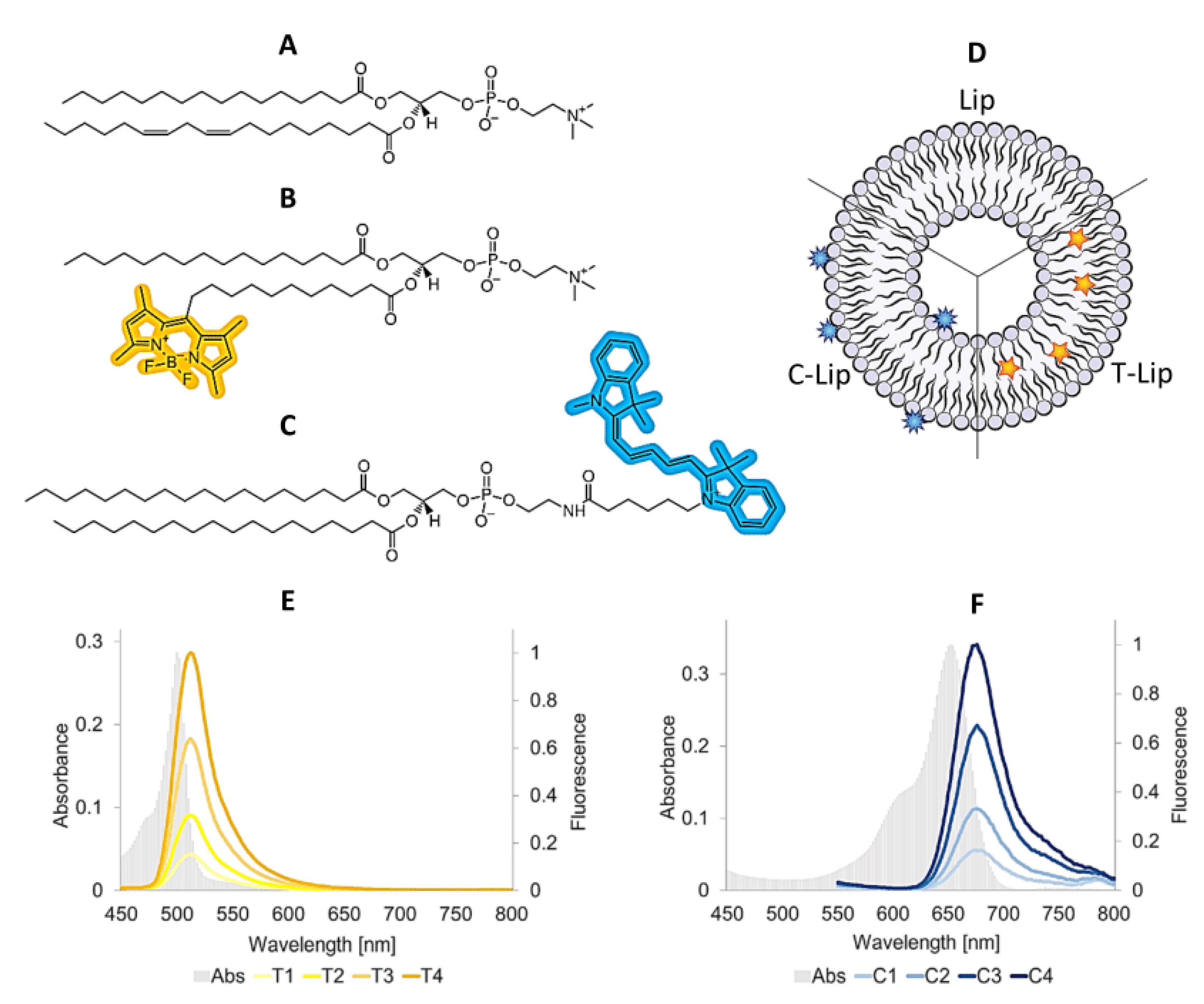
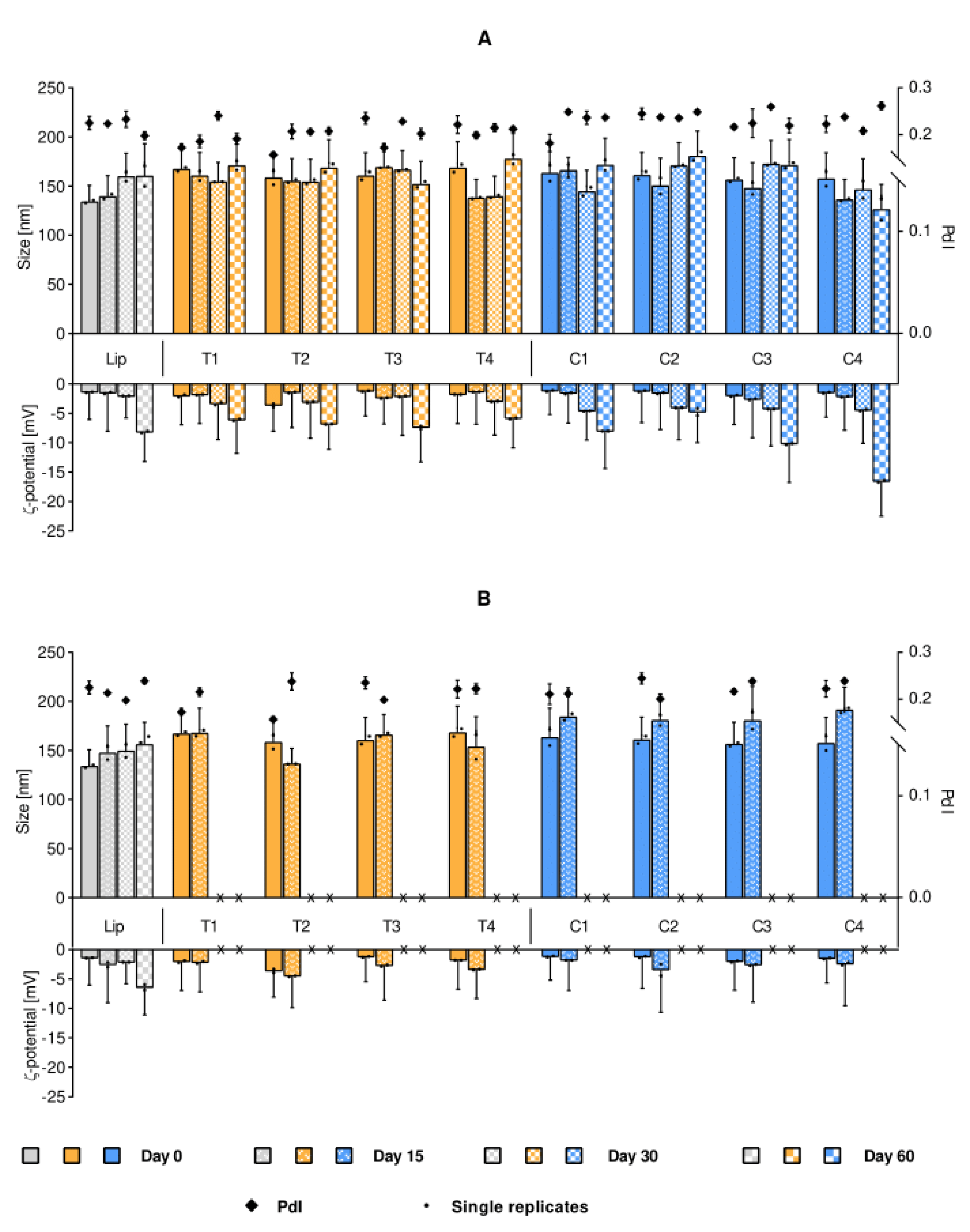
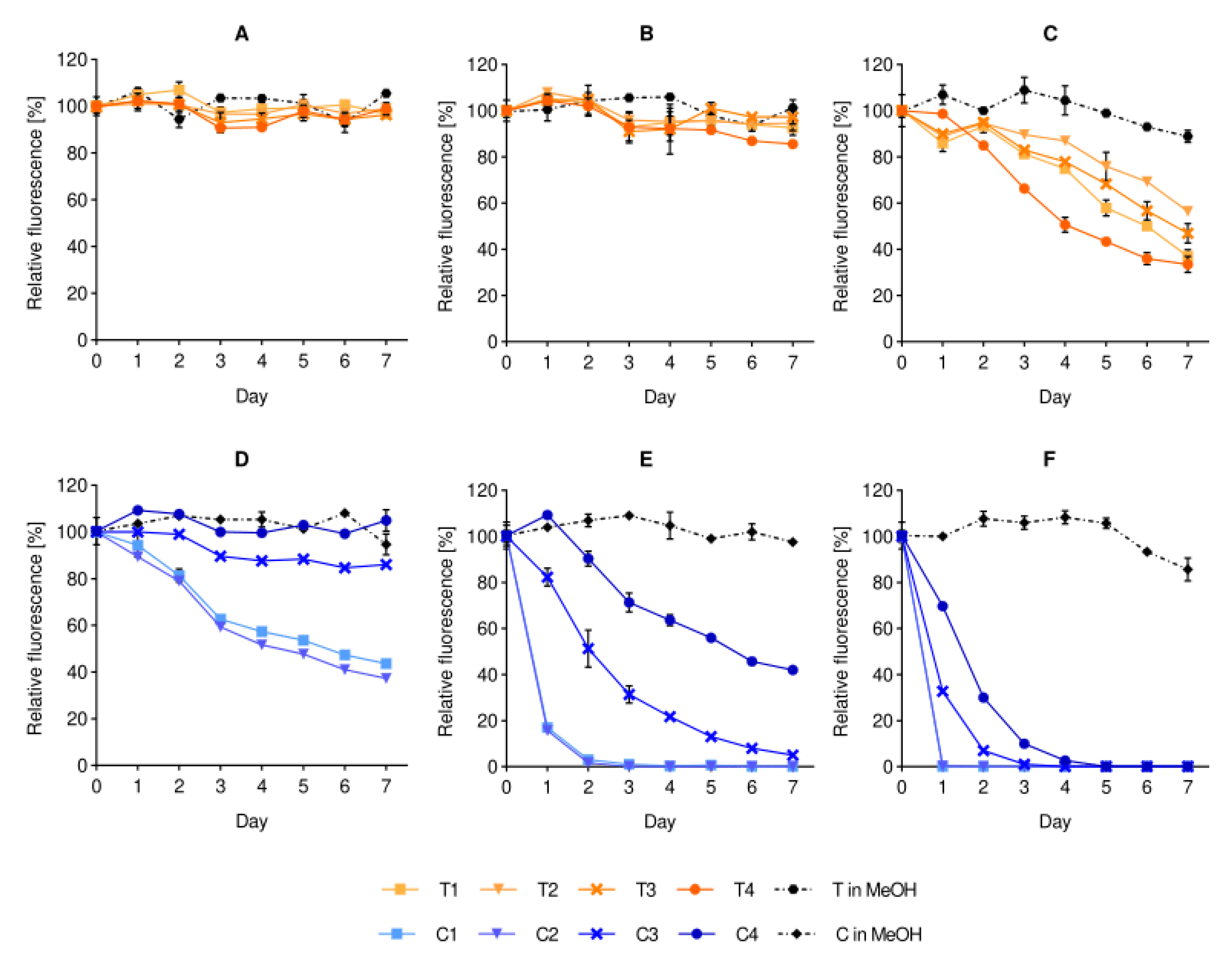

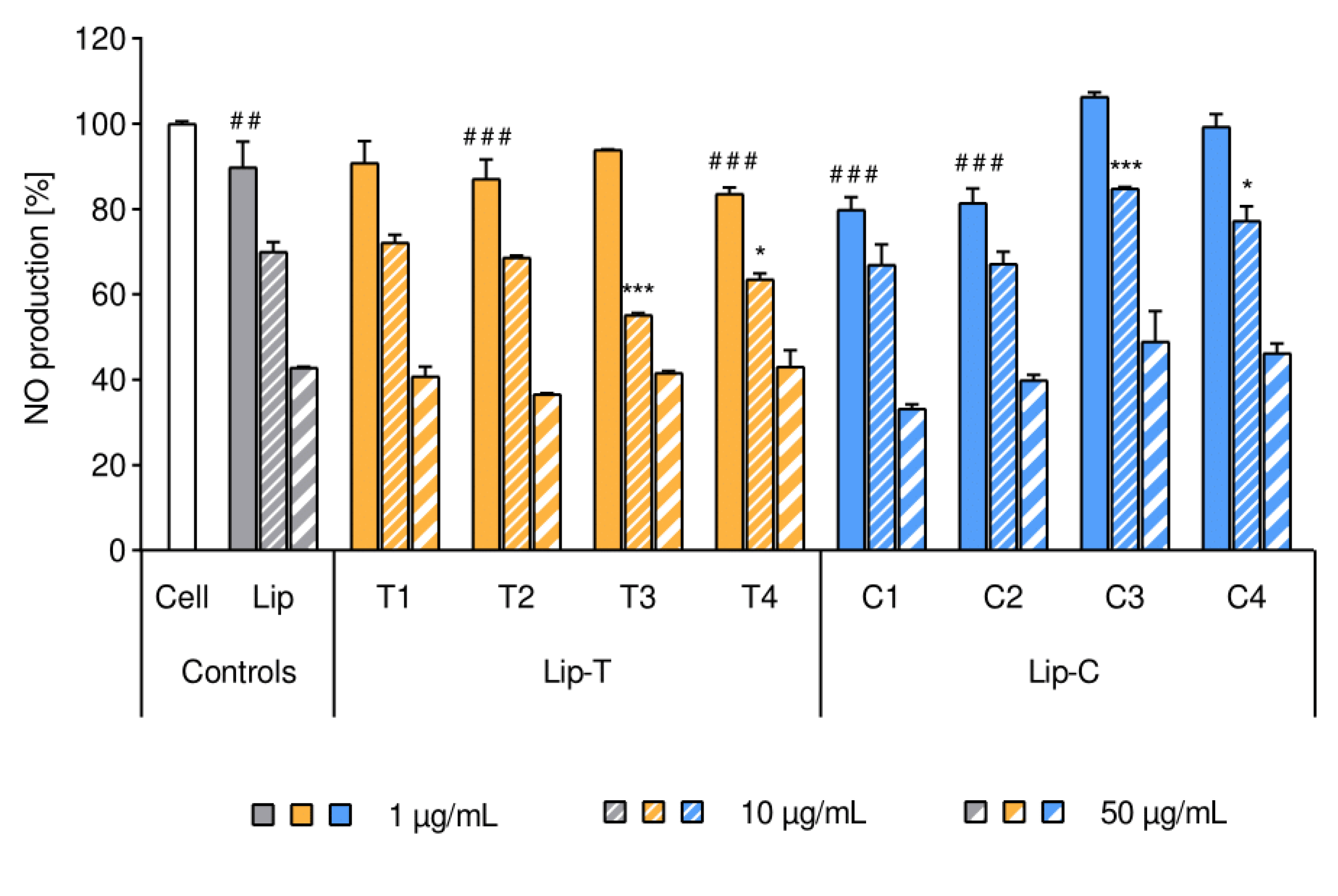
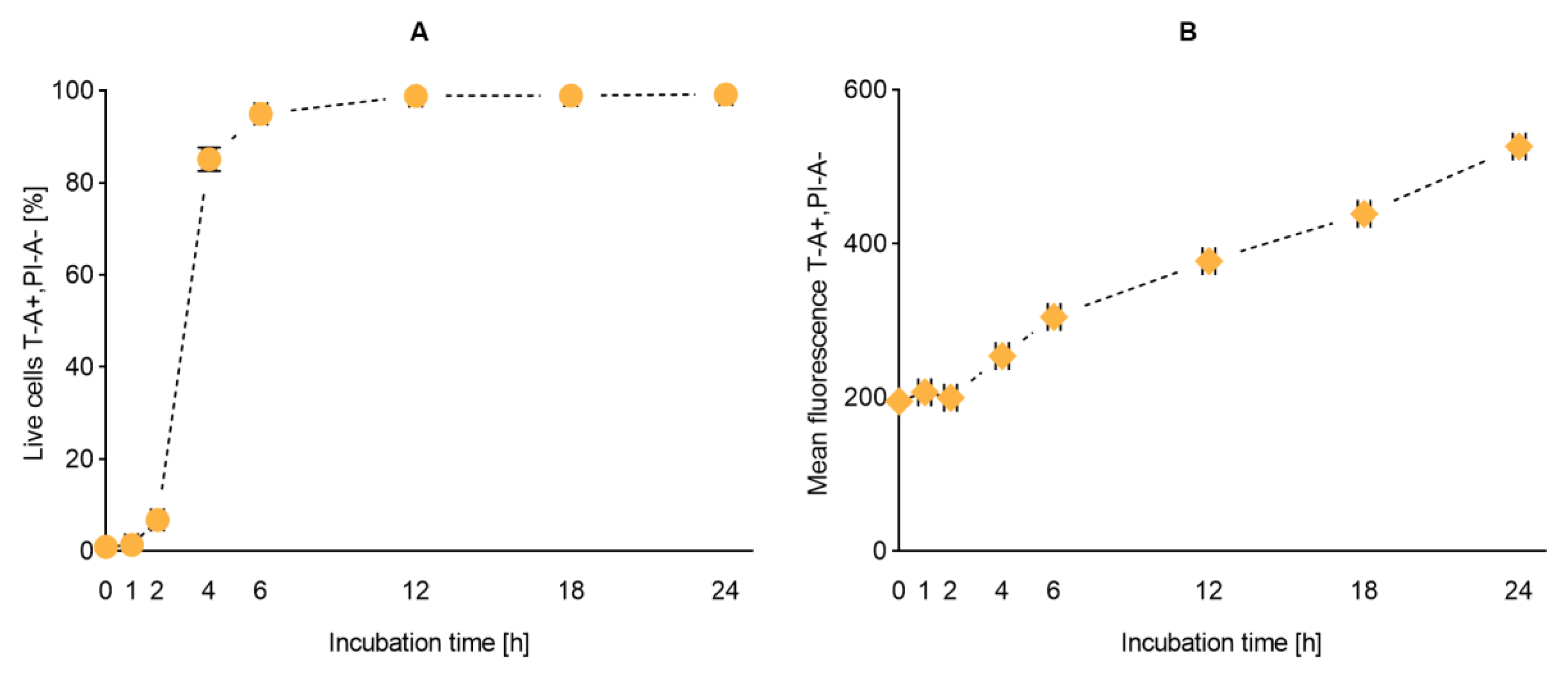

| Type of Liposomes | Fluorescent Dye | Vesicle Size | ζ-Potential | |||
|---|---|---|---|---|---|---|
| T [mg/mL] | C [mg/mL] | Peak 1 [nm (%)] | Peak 2 [nm (%)] | PdI | [mV] | |
| Lip | - | - | 135 ± 1 (88%) | 38 ± 1 (12%) | 0.23 ± 0.01 | -1.4 ± 0.1 |
| T1 | 0.015 | - | 167 ± 2 (95%) | 39 ± 11 (5%) | 0.17 ± 0.01 | −2.0 ± 0.2 |
| T2 | 0.030 | - | 158 ± 7 (96%) | 35 ± 12 (4%) | 0.16 ± 0.01 | −3.6 ± 0.3 |
| T3 | 0.060 | - | 160 ± 4 (95%) | 35 ± 4 (5%) | 0.20 ± 0.04 | −1.2 ± 0.1 |
| T4 | 0.120 | - | 168 ± 4 (89%) | 42 ± 3 (11%) | 0.22 ± 0.01 | −1.8 ± 0.0 |
| C1 | - | 0.015 | 163 ± 8 (94%) | 35 ± 1 (6%) | 0.21 ± 0.01 | −1.2 ± 0.1 |
| C2 | - | 0.030 | 161 ± 4 (89%) | 40 ± 1 (11%) | 0.24 ± 0.01 | −1.2 ± 0.1 |
| C3 | - | 0.060 | 156 ± 1 (93%) | 37 ± 1 (7%) | 0.22 ± 0.01 | −2.0 ± 0.1 |
| C4 | - | 0.120 | 157 ± 7 (89%) | 39 ± 8 (11%) | 0.22 ± 0.01 | −1.5 ± 0.1 |
© 2020 by the authors. Licensee MDPI, Basel, Switzerland. This article is an open access article distributed under the terms and conditions of the Creative Commons Attribution (CC BY) license (http://creativecommons.org/licenses/by/4.0/).
Share and Cite
Cauzzo, J.; Nystad, M.; Holsæter, A.M.; Basnet, P.; Škalko-Basnet, N. Following the Fate of Dye-Containing Liposomes In Vitro. Int. J. Mol. Sci. 2020, 21, 4847. https://doi.org/10.3390/ijms21144847
Cauzzo J, Nystad M, Holsæter AM, Basnet P, Škalko-Basnet N. Following the Fate of Dye-Containing Liposomes In Vitro. International Journal of Molecular Sciences. 2020; 21(14):4847. https://doi.org/10.3390/ijms21144847
Chicago/Turabian StyleCauzzo, Jennifer, Mona Nystad, Ann Mari Holsæter, Purusotam Basnet, and Nataša Škalko-Basnet. 2020. "Following the Fate of Dye-Containing Liposomes In Vitro" International Journal of Molecular Sciences 21, no. 14: 4847. https://doi.org/10.3390/ijms21144847
APA StyleCauzzo, J., Nystad, M., Holsæter, A. M., Basnet, P., & Škalko-Basnet, N. (2020). Following the Fate of Dye-Containing Liposomes In Vitro. International Journal of Molecular Sciences, 21(14), 4847. https://doi.org/10.3390/ijms21144847









